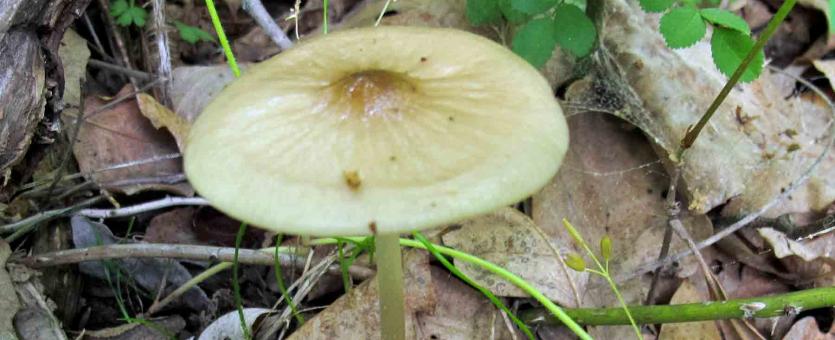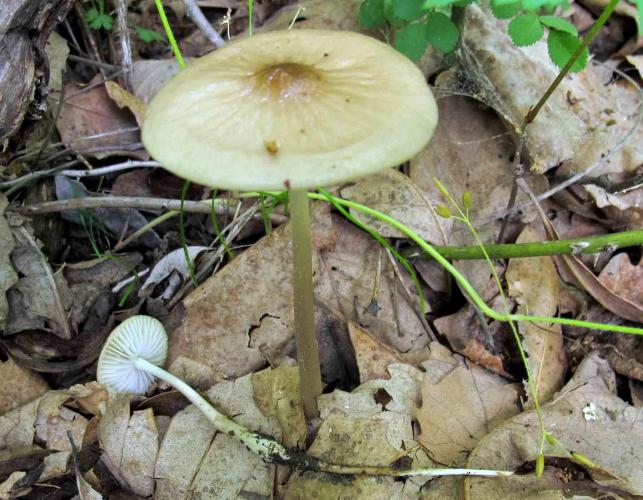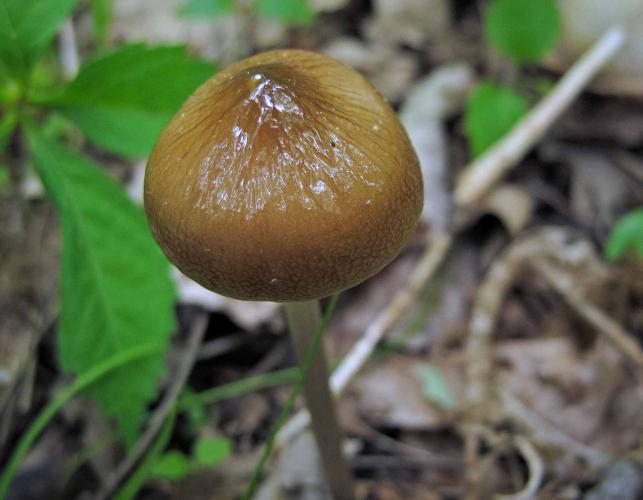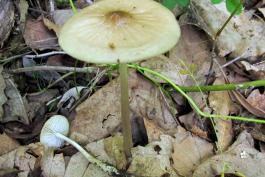
Grayish brown, flat cap and a long, slender stalk that continues underground. Grows singly or scattered on and around deciduous trees and stumps. July–October. Cap slightly convex, becoming flat, with a knob in the center; grayish brown to dark brown; center knob is darker; texture tacky or moist; surface wrinkled. Gills broad; spacing distant; white; attached. Stalk enlarging toward the soil line; continues rootlike under the soil and tapers to a point; whitish above the soil, brownish below; snaps when broken. Spore print white. Spores magnified are smooth, colorless, elliptical.
Lookalikes: There are many other brownish mushrooms, but this one has a “root.” When it comes to the many Xerula species, proper identification really depends on microscopic examination.
Cap width: 1–4 inches; stalk length: 2–8 inches; stalk width: ⅛–⅜ inch.

Statewide.
Habitat and Conservation
Grows singly or scattered on and around deciduous trees and stumps. The underground rootlike portion of the stem can be as long as the aboveground part. Gently dig away soil around the stem to see the rooted collybia's "root." Although these mushrooms take nourishment from rotting or dying wood or roots, they grow from the soil and are not usually directly connected to wood.
Status
Considered a good edible. The cap of this species is a meaty and fairly tasty addition to an edible collection.
Life Cycle
This species exists most of the time as a network of fungal cells (mycelium) within rotting logs, branches, or roots. The mycelium obtains nourishment by digesting, and rotting, the wood. When ready to reproduce, the mycelium develops mushrooms, which are reproductive structures. Spores are produced in the gills and are released to begin new mycelia elsewhere. The mycelium of a mushroom can live for years.
Human Connections
Humans have eaten mushrooms for thousands of years, in many cultures. Sometimes they are eaten for their nutritional and culinary value; sometimes they are considered medicinal. Be absolutely sure of your identifications before you consume wild mushrooms!
Ecosystem Connections
This fungus is a saprobe, taking nourishment from decaying wood. It's easy to overlook the importance of fungi that decompose dead wood, but imagine what the forest would look like if all the fallen trees and leaves didn't break down!






Mushrooms are a lot like plants, but they lack chlorophyll and have to take nutrients from other materials. Mushrooms are neither plants nor animals. They are in a different kingdom — the fungi. Fungi include the familiar mushroom-forming species, plus the yeasts, molds, smuts, and rusts.
Always be cautious when eating edible mushrooms. Be absolutely sure of the ID, and only eat a small amount the first time you try it to avoid a reaction..





















